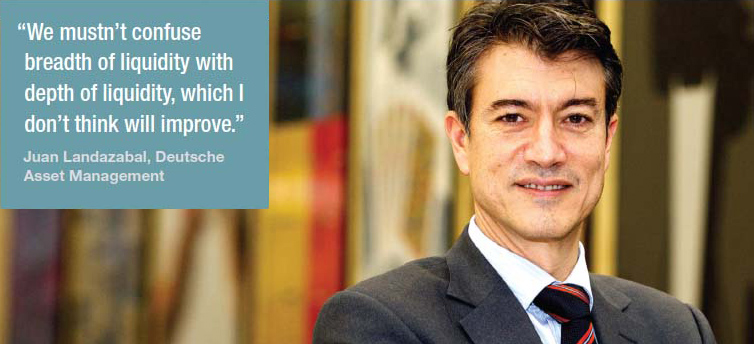Keep an eye on these potential points of failure, writes Dan Barnes.
For trading desks the impact of the new Markets in Financial Instruments Directive / Regulation (MiFID II/MiFIR) can most easily be felt on two levels: the impact on market activity and the impact on the firm. Market activity will be most disrupted as new workflows are tested and parts of the transaction chain put under tension for the first time.
Many traders expect liquidity in fixed income to be challenged by post-trade transparency and potential disconnects in trading. The most obvious causes for disruption might occur if firms find that they are unable to trade because they lack the right documentation, or because they are unable to provide the right data for the reporting requirements.
For traders, worn down by internal meetings and endless discussions about preparedness for the new rules, it could be hard to see the wood for the trees on day one.

“If you are a medium-sized buy-side player who thinks this is going to tick over without having spent much effort on it, you may find yourself hit with the stark reality that in 2018, all of a sudden, you have to remediate a whole bunch of MiFID implementation that you didn’t get done in 2017, very quickly,” says PJ Di Giammarino, CEO of think tank JWG-IT.
Data capture and reporting
MiFID II hinges upon the reporting and capture of information that can prove firms are working towards its goals, whilst simultaneously creating a more quantified understanding of the market. Providing best execution reports for each group of bonds traded, both liquid and illiquid, requires a huge effort in terms of documentation. Investment firms will be publishing best execution reports under RTS 28 on an annual basis, detailing the top five execution venues and the execution quality they achieved. Transaction reporting obligations under Article 26 of MiFIR require highly detailed reports to be filed, which mean that firms must invest significantly in data aggregation tools that can be used to support the process.

“We have to describe the pre-trade indicators that feed into the best execution decision making process,” said Fabien Orève, global head of trading at Candriam Investors Group, speaking at the Fixed Income Leaders’ Summit (FILS) in Amsterdam on 8 November 2017.
Investment firms will need to ensure that they are making the best use of pre-trade data from systems like Algomi ALFA, B2Scan and the Neptune data model in order to support the trading process, and then using post-trade data in combination with that pre-trade input to assess the ability of the trading desk to improve execution quality, and of counterparties / venues to deliver better outcomes.
Orève noted that it will be important that buy-side firms can employ a fully integrated order / execution management system (OEMS) to great effect when collecting relevant data like trade history. However, it is possible that firms might find themselves relying too heavily on third party providers.

“I think one of the biggest challenges is the potential disconnect between what people are being promised by their providers, and then what is being delivered in practice,” says Rebecca Healey, head of Market Structure & Strategy at block trading venue Liquidnet. “There are a lot of firms who are banking on vendors being able to deliver all that has been promised to them. Only time will tell whether that actually comes to pass or not, from the research that I am conducting at the moment that is a concern.”
The wrong type of data
Under Regulatory Technical Standard 27 (RTS 27), publicly accessible annual reports must also be released by trading venues and systematic internalisers (SIs), including data that shows the quality of execution of transactions on that venue – price, costs, speed, and likelihood of execution – while execution venues including market makers and other liquidity providers must publish the same reports on a quarterly basis.
Data underpins the reporting process, but now is also a key to trading. As trades that are not accompanied by the necessary data, such as legal entity identifiers (LEIs), cannot be processed, firms make face a situation in which they may have to prevent a trade from occurring.
“You can sense a level of frustration amongst the regulators, they have been saying for a while now ‘No LEI, no trade,’” says Healey. “It’s not just for any investment firm that operates in Europe and their clients, it’s also for those firms that issue securities. The industry hadn’t really considered that as a requirement, it has been focused on stage right and missed stage left.”
The risk of failing to report accurately also looms large, for multilateral trading facilities particularly.
“The first order problems will be the trade just doesn’t get reported, and that is pretty easy to spot,” says Di Giammarino. “The next order problem will be the big issues of data quality, like identifiers that aren’t in line or don’t exist, and the sequence of data put into the trade that doesn’t match with the data quality rules prescribed by the regulators.”
‘Process trades’ which are negotiated offline and then inputted onto a trading platform are a cause of concern for the UK’s Financial Conduct Authority (FCA), although apparently less so for other authorities.
For example, if a trade is agreed between a bank and asset manager and the asset manager then books it in through a venue for reporting purposes, the venue must report it via RTS 27 and the investment manager via RTS 28, which would include the venue as the place of execution but not the bank. The bank would not need to report the trade as it would not be considered a direct trade.
The issue is that the detail of the sell-side participation in the trade would not be captured, limiting the value of disclosure. Venues are also concerned that if a trade is not reported correctly they could be in breach of compliance when they are not in a position to enforce the reporting of correct information without blocking trades.
Article 21 of MiFIR requires investment firms and SIs to publish details of over-the-counter (OTC) transactions within 15 minutes, via Approved Publication Arrangements (APAs). The report has to detail the instrument traded, the nature of the transaction, price and volume. While the data in these reports is not so hard to aggregate the impact of publishing these reports is expected to be enormous.
Liquidity transformed
Clearly if firms can access reports from other traders they can assess their positions. Historically such disclosure has had a negative impact on turnover. The introduction of the Trade Reporting and Compliance Engine (TRACE) in the US, which rolled out from 1 January 2002 to 9 January 2006, created real-time transparency across high yield and investment grade corporate bonds.
A 2013 paper by academics from the Massachusetts Institute of Technology (MIT) entitled ‘The Effects of Mandatory Transparency in Financial Market Design’ noted that “post-trade transparency of price and volume leads to a significant reduction in trading activity and price dispersion” while also observing that “transparency affects different segments of the same market in different ways. As a consequence, our results provide empirical support for the view that not every segment of each security market should be subject to the same degree of mandated transparency.”

A similar outcome is expected when Europe is pushed into post-trade transparency. Although an increase in post-trade data might assist in firms’ ability to find liquidity and pricing that does not have the same impact as engagement in trading warned Juan Landazabal, head of trading at Deutsche Asset Management.
“We mustn’t confuse breadth of liquidity with depth of liquidity, which I don’t think will improve,” he said at November’s FILS event in Amsterdam.
A polarisation of liquidity between smaller low touch orders and larger higher touch orders seems likely, which could impact the approach to trading that buy-side desks currently employ. However, that could also affect the historical data models for pricing and liquidity that desks are currently employing. If spreads widen, as seems likely, and trades are bifurcated between low and high touch, trade reports alone may be hard pushed to explain the qualitative difference in execution quality pre- and post-3 January 2018.
The light at the end of MiFID
MiFID is not all risk; there is some reward, albeit likely delayed beyond the first half of 2018. The price transparency and best execution information reporting will help in developing price formation and awareness of liquidity concentration. The smart trader will work out ways to minimise information leakage and put pressure on spreads during execution, whilst exploiting the capacity to use publicly available information.
“I expect to see an evolution of high touch trading within low touch; there is only a certain amount of liquidity, and we saw in equities only a certain amount of instruments can be 100% automated,” says Healey. “In the same way you traded a single name equity and then went into programme trades in the automated space, it was a multi-faceted, multi-layered approach, which I think is going to be of more interest to fixed income trading desks.”
©Markets Media Europe 2025












